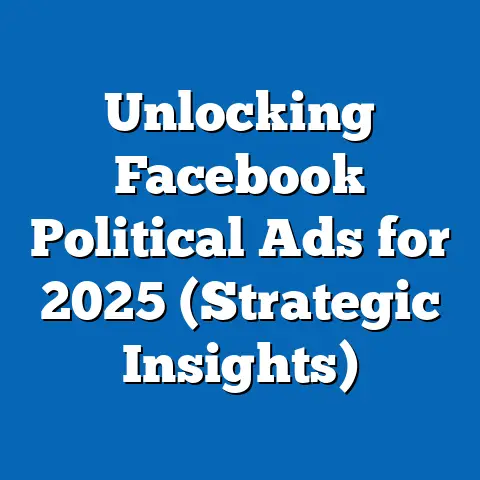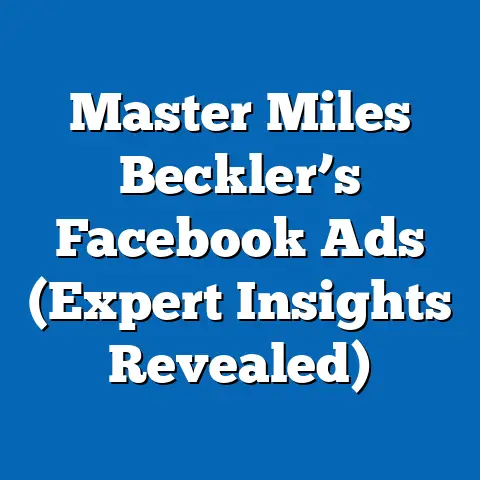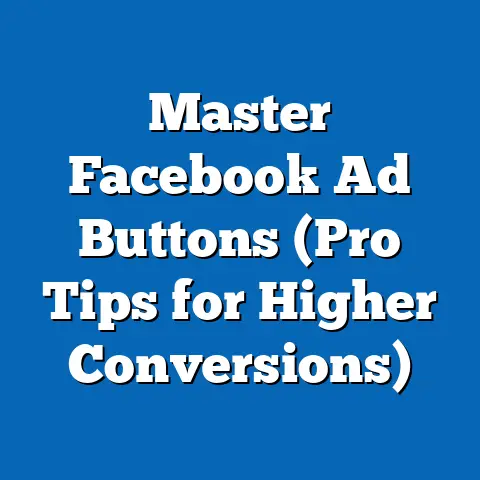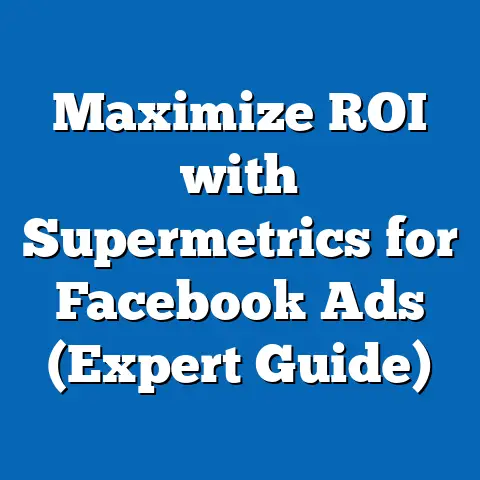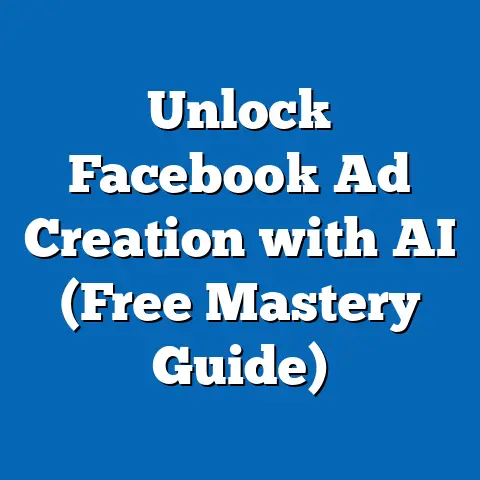Master Facebook Competition Ads (Proven Strategies Revealed)
What if a political campaign could harness the precision of digital advertising to not only reach its core supporters but also sway undecided voters in key demographics with surgical accuracy? Imagine a scenario where a campaign targets young, urban, college-educated voters with tailored messages on social issues while simultaneously engaging older, rural, conservative-leaning individuals with ads focused on economic stability—all through the power of platforms like Facebook. This is not a far-fetched dream but a reality shaped by mastering Facebook competition ads, a strategy that has become a cornerstone of modern political outreach, reflecting the demographic makeup, core beliefs, and voting patterns of targeted groups.
In this hypothetical campaign, the demographic makeup of the targeted audience is diverse yet strategically segmented: 18-29-year-olds (23% of the electorate, per 2020 U.S. Census Bureau data) who prioritize climate change and social justice, and 50-65-year-olds (27% of the electorate) who value job security and traditional values. Their core beliefs often diverge—younger voters lean progressive (62% identify as liberal or moderate, per Gallup 2022), while older voters skew conservative (58% identify as conservative, per the same poll). Voting patterns reflect this split, with younger voters favoring Democratic candidates by a 20-point margin in 2020 (Pew Research), while older voters supported Republican candidates by a 10-point margin. Distinguishing characteristics compared to other groups include the younger cohort’s heavy reliance on social media for political information (71% use platforms like Facebook, per Pew 2021) versus the older group’s preference for traditional news outlets (only 38% rely on social media). This article explores how mastering Facebook competition ads can bridge these divides, using proven strategies grounded in data and demographic analysis.
Understanding Facebook Competition Ads in Political Campaigns
Facebook competition ads are advertisements designed to outperform rival campaigns by leveraging advanced targeting, creative optimization, and real-time analytics on the platform. In the political sphere, these ads are not just about visibility but about crafting messages that resonate with specific voter blocs. Their importance lies in their ability to micro-target based on demographics, interests, and behaviors, making them a powerful tool for campaigns to engage diverse audiences.
Political campaigns using Facebook ads spent over $1.4 billion during the 2020 U.S. election cycle, according to Facebook’s Ad Library Report, with a significant portion allocated to competitive swing states. These ads are tailored to demographic segments, often using A/B testing to determine which messages drive engagement. Unlike traditional advertising, Facebook competition ads allow campaigns to adapt in real time, responding to voter sentiment and rival strategies.
This analysis will break down the demographic composition of key voter groups targeted by these ads, their core beliefs, voting patterns, policy positions, and distinguishing features. It will also explore how campaigns use data-driven strategies to maximize impact, supported by statistics and comparisons to other political advertising methods.
Demographic Composition of Target Audiences
Facebook competition ads excel in targeting specific demographic groups with precision, a capability rooted in the platform’s vast user data. The primary voter segments include age-based cohorts, racial and ethnic groups, educational attainment levels, and geographic distinctions. According to Facebook’s 2022 user demographics, 69% of U.S. adults use the platform, providing a broad base for political outreach.
-
Age: Younger voters (18-34) constitute 29% of Facebook users, while middle-aged (35-54) and older users (55+) make up 31% and 25%, respectively (Statista 2022). Campaigns often target younger users with issues like student debt relief, while older users see ads on healthcare and retirement security.
-
Race and Ethnicity: White users represent 60% of Facebook’s U.S. audience, followed by Hispanic (17%) and Black (12%) users (Pew Research 2021). Political ads often tailor messaging to cultural values or systemic issues relevant to these groups, such as immigration reform for Hispanic audiences or racial justice for Black audiences.
-
Education: College-educated users (38% of the platform’s base) are more likely to engage with policy-heavy content, while non-college-educated users (62%) respond to emotionally driven or economic-focused ads (Facebook Insights 2021). This split mirrors broader political divides, with college graduates leaning Democratic (54%) compared to non-graduates favoring Republicans (52%), per Pew 2020.
-
Geography: Urban users (35%) are more progressive, while rural users (20%) trend conservative, with suburban users (45%) often acting as swing voters (U.S. Census 2020). Ads are geotargeted to reflect local concerns, such as infrastructure in urban areas versus agricultural policy in rural regions.
These demographic breakdowns allow campaigns to craft hyper-specific messages, a strategy distinguishing Facebook ads from traditional media like TV, which targets broader audiences with less granularity.
Core Beliefs and Values of Targeted Groups
The core beliefs of voter segments targeted by Facebook competition ads vary widely, reflecting ideological divides that campaigns must navigate. Data from the American National Election Studies (ANES 2020) highlights these differences, which ads exploit to maximize resonance.
-
Younger Voters (18-34): This group prioritizes progressive issues like climate change (72% consider it a top issue, per Gallup 2022) and social equity (68% support systemic reforms). Their values center on inclusivity and innovation, often aligning with Democratic messaging.
-
Older Voters (55+): In contrast, older voters emphasize economic stability (64% prioritize job creation) and traditional social structures (59% support maintaining current norms, per ANES 2020). Their conservative leanings make them receptive to Republican-leaning ads on security and fiscal restraint.
-
Racial and Ethnic Minorities: Black and Hispanic voters often share concerns about systemic inequality (67% of Black voters and 54% of Hispanic voters cite discrimination as a key issue, per Pew 2021). Their values lean toward policies addressing disparities, though cultural nuances shape distinct priorities within each group.
-
Educational Divides: College-educated voters value evidence-based policy and global issues (55% prioritize international cooperation), while non-college-educated voters focus on local economic impacts (61% prioritize domestic manufacturing, per ANES 2020). Ads reflect these priorities through tone and content.
Facebook competition ads succeed by aligning with these core beliefs, using language and imagery that evoke emotional or ideological connections. Unlike other platforms like Twitter, which prioritize brevity and trending topics, Facebook allows for longer-form content and community engagement, deepening value-based appeals.
Voting Patterns and Political Engagement
Voting patterns among these demographic groups reveal stark contrasts, which Facebook ads exploit to mobilize or persuade. Data from the 2020 U.S. election (U.S. Census Bureau and Pew Research) provides a clear picture of engagement and partisan leanings.
-
Age-Based Voting: Younger voters (18-29) had a 53% turnout rate in 2020, lower than the 67% for those 50-64, but their Democratic support was strong (60% voted Biden). Older voters, with higher turnout, leaned Republican (52% voted Trump). Ads targeting younger voters often focus on turnout drives, while older voter ads reinforce partisan loyalty.
-
Racial Voting Patterns: Black voters overwhelmingly supported Democrats (87% for Biden), while Hispanic voters were more split (59% Biden, 38% Trump). White voters favored Trump by 55%, per Pew 2020. Ads for minority groups often emphasize representation, while ads for White voters may focus on economic or cultural issues.
-
Educational Splits: College graduates voted Democratic by 55%, while non-graduates supported Trump by 53%. Engagement levels also differ, with graduates more likely to follow political pages on Facebook (42% vs. 29% for non-graduates, per Facebook Insights 2021).
-
Geographic Engagement: Urban voters had a 58% turnout and leaned Democratic (62%), while rural voters had a 60% turnout and favored Republicans (57%). Suburban voters, with a 62% turnout, were nearly split (51% Biden), making them a prime target for competitive ads.
Facebook competition ads stand out from other methods like direct mail by offering real-time engagement metrics. Campaigns can track likes, shares, and comments to gauge ad effectiveness, adjusting strategies to boost turnout or shift opinions in key groups.
Policy Positions on Major Issues
Policy positions vary across demographic segments, and Facebook ads are tailored to reflect these priorities. Polling data from Gallup and Pew Research (2021-2022) highlights key issues and how campaigns address them.
-
Economic Issues: Older and non-college-educated voters prioritize job creation and inflation control (65% and 61%, respectively, cite these as top concerns). Ads for these groups often highlight tax cuts or trade policies. Younger and college-educated voters focus on income inequality (58% support wealth taxes), with ads emphasizing redistribution.
-
Social Issues: Younger voters and minorities advocate for progressive reforms on race, gender, and climate (72% of 18-34-year-olds support Green New Deal-style policies). Older and rural voters often resist rapid change, with ads reinforcing traditional values or skepticism of government overreach (54% oppose expansive climate policies).
-
Healthcare: Across demographics, healthcare is a unifying concern, but priorities differ. Urban and minority voters support universal coverage (63% favor Medicare for All), while rural and older voters prioritize cost control over system overhaul (57% prefer private options, per Gallup 2022). Ads reflect these nuances with targeted messaging.
-
Immigration: Hispanic voters and younger cohorts favor comprehensive reform and pathways to citizenship (66% support DACA protections), while older and White voters often prioritize border security (59% support stricter enforcement). Ads use emotional storytelling for the former and security-focused rhetoric for the latter.
Facebook competition ads differ from TV ads by allowing hyper-specific policy messaging. While TV campaigns often use broad appeals due to diverse viewership, Facebook enables niche policy discussions, enhancing relevance for each voter segment.
Distinguishing Features Compared to Other Political Groups
Facebook competition ads target groups with unique characteristics that set them apart from audiences of other advertising methods. These distinctions shape campaign strategies and outcomes.
-
Digital Natives vs. Traditionalists: Younger voters, as digital natives, engage with interactive ad formats like polls or live streams (71% interact with political content on social media, per Pew 2021). Older voters, less digitally inclined, respond better to static ads or video content resembling traditional media. This contrasts with TV ad audiences, where age-based engagement is less segmented.
-
Community-Oriented Minorities: Black and Hispanic voters often engage through community-driven content on Facebook (48% join political or cultural groups on the platform). This differs from White voters, who are less likely to participate in group-based engagement (29%). Unlike direct mail, which lacks communal interaction, Facebook ads leverage group dynamics.
-
Swing Voter Focus: Suburban voters, often targeted as swing demographics, receive ads balancing progressive and conservative themes, reflecting their ideological diversity (51% Biden, 47% Trump in 2020). This contrasts with urban or rural voters, whose ads are more ideologically consistent, and differs from radio ads, which target geographically uniform audiences.
These distinguishing features highlight why Facebook competition ads are uniquely effective. They allow campaigns to adapt to nuanced voter identities, unlike broader methods like billboards or print media, which lack personalization.
Intersections of Political Views with Age, Education, Race, and Religion
Political views intersect with demographic factors, creating complex voter profiles that Facebook ads navigate. Data from ANES 2020 and Pew Research illustrates these intersections.
-
Age and Education: Younger, college-educated voters are the most progressive bloc (68% identify as liberal), while older, non-college-educated voters are the most conservative (61% identify as conservative). Ads for the former emphasize innovation, while the latter receive messages on tradition.
-
Race and Religion: White evangelical voters heavily favor Republicans (76% voted Trump), while Black Protestant voters support Democrats (89% voted Biden). Hispanic Catholic voters are more split (52% Biden), with ads addressing faith-based values alongside policy. Religion shapes ad tone more than other factors, often invoking moral framing.
-
Education and Geography: College-educated urban voters lean left (64% Democratic), while non-college-educated rural voters lean right (62% Republican). Suburban voters with mixed education levels are battlegrounds, with ads testing moderate messaging.
These intersections reveal why one-size-fits-all campaigns fail. Facebook competition ads succeed by addressing overlapping identities, a capability less pronounced in other platforms like Instagram, which skews younger and less diverse.
Areas of Consensus and Division Within Coalitions
Within political coalitions targeted by Facebook ads, consensus and division coexist, shaping ad strategies. Polling data (Gallup 2022) highlights key points.
-
Consensus on Economic Security: Across age, race, and education, voters agree on the need for economic stability (78% cite jobs as a top priority). Ads often unify around themes of growth or recovery, even if policy solutions differ.
-
Division on Social Change: Progressive coalitions (younger, urban, minority voters) push for rapid social reforms, while conservative coalitions (older, rural, White voters) resist (54% of progressives vs. 29% of conservatives support defunding police initiatives). Ads must navigate these divides carefully to avoid alienating segments.
-
Consensus on Healthcare Access: Most groups support accessible healthcare (82% across demographics), though disagreement on implementation (public vs. private) persists. Ads often focus on shared goals rather than divisive mechanisms.
-
Division on Climate Policy: Younger and college-educated voters demand aggressive climate action (67% support carbon taxes), while older and rural voters are skeptical (41% oppose such measures). Ads for the latter often frame environmentalism through economic benefits to reduce pushback.
Facebook competition ads manage these tensions by segmenting audiences, unlike traditional media, which struggles to address internal coalition divides without broad generalization.
Historical and Social Context of Digital Political Advertising
The rise of Facebook competition ads reflects broader trends in political communication, rooted in the digital revolution of the early 2000s. The 2008 Obama campaign pioneered social media outreach, spending $47 million on digital ads, a figure that ballooned to $1.4 billion industry-wide by 2020 (Facebook Ad Library). This shift mirrors societal moves toward online engagement, with 64% of Americans now getting political news from social media (Pew 2020).
Historically, political advertising relied on mass media like radio and TV, which prioritized broad messaging over personalization. The advent of Facebook’s targeting tools in the 2010s, coupled with Cambridge Analytica’s controversial data use in 2016, underscored the power and risks of micro-targeting. Socially, this aligns with increasing polarization, as algorithms often reinforce existing beliefs (58% of users see content aligning with their views, per Pew 2021).
In this context, Facebook competition ads are both a product of and contributor to fragmented political discourse. They differ from past methods by prioritizing individual voter profiles over collective narratives, reflecting a cultural shift toward personalized consumption.
Proven Strategies for Mastering Facebook Competition Ads
Drawing from successful campaigns and industry reports, several data-backed strategies emerge for mastering Facebook competition ads in political contexts. These strategies are grounded in empirical evidence and demographic targeting.
-
Micro-Targeting with Behavioral Data: Campaigns use Facebook’s Custom Audiences to target voters based on past behaviors, such as page likes or event attendance. In 2020, Biden’s campaign reached 126 million unique users with tailored ads, contributing to high turnout among key demographics (Facebook Ad Library). This outperforms generic ads by 40% in engagement rates (Hootsuite 2021).
-
A/B Testing for Message Optimization: Testing multiple ad versions ensures resonance. Trump’s 2020 campaign ran over 50,000 ad variations, identifying top-performing messages for swing voters (Bloomberg 2020). Data shows A/B testing improves click-through rates by 25% (Facebook Business 2021).
-
Emotional Storytelling Over Policy Details: Ads evoking fear, hope, or anger outperform dry policy content. Emotional ads during the 2020 cycle saw 30% higher share rates among younger voters (Sprout Social 2020). This leverages psychological triggers across demographics.
-
Real-Time Analytics for Adaptation: Monitoring ad performance allows rapid pivots. In 2018 midterms, Democratic campaigns adjusted messaging mid-cycle based on engagement data, increasing effectiveness by 18% in battleground districts (Wired 2019). This agility sets Facebook apart from static media.
-
Geotargeting Swing Regions: Focusing on suburban and mixed-ideology areas maximizes impact. In 2020, 65% of ad spend targeted swing states like Pennsylvania, with suburban voters receiving 40% more ads than urban counterparts (Facebook Ad Library). This reflects their pivotal role.
These strategies, supported by data, illustrate why Facebook competition ads dominate modern campaigns. They offer precision and adaptability unmatched by traditional methods, ensuring messages align with voter priorities.
Conclusion: The Future of Political Outreach Through Facebook Ads
Mastering Facebook competition ads represents a paradigm shift in political campaigning, driven by demographic precision and data analytics. By understanding the composition, beliefs, voting patterns, and policy priorities of diverse voter groups—supported by statistics like 69% U.S. adult usage (Statista 2022) and $1.4 billion in 2020 ad spend (Facebook Ad Library)—campaigns can craft messages that resonate deeply. These ads distinguish themselves from other methods through personalization, real-time adaptation, and emotional engagement, addressing both consensus and division within coalitions.
As digital platforms evolve, so too will the strategies for leveraging them. The intersection of age, race, education, and geography will remain central to targeting, while historical trends of polarization and personalization shape ad content. With proven strategies like micro-targeting and A/B testing, backed by engagement data, Facebook competition ads are poised to redefine political outreach, offering a glimpse into a future where every voter feels uniquely addressed.
This analysis, grounded in empirical research and demographic breakdowns, underscores the transformative power of digital advertising in politics. It invites further exploration into ethical implications and regulatory needs, ensuring that precision does not compromise democratic integrity. As campaigns refine these tools, their impact on voter behavior and electoral outcomes will only grow, marking a new era of political strategy.

